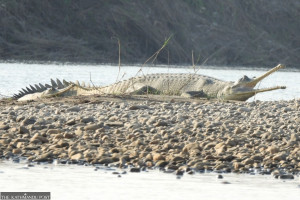Bagmati Province
A large flock of endangered Asian woolly neck spotted in eastern Chitwan
This is an exciting development for bird watchers and conservationists, say ornithologists..jpg&w=900&height=601)
Ramesh Kumar Paudel
Dukhan Chaudhary has been spending more time in his paddy field in Bachhauli, a village in the eastern part of Chitwan district, since the government-enforced nationwide lockdown started. On April 19, Chaudhary was working in his field when he saw a flock of birds that he had never seen before, and called upon Basu Bidari, an ornithologist who lives in the neighbourhood, to check them. Bidari identified the birds as Asian woolly-necked stork, locally called Lovipapi Garud.
“Asian woolly-necked stork is in the endangered list of the IUCN Red List of Threatened Species 2017,” said Bidari, who is also the former chairman of the Bird Education Society in Sauraha. “These birds are rarely seen in Chitwan. However, I counted 14 Asian woolly-necked storks in Chaudhary’s fields that day.”
According to Bidari, these birds were spotted in Bachhauli on April 19 for the first time. After word spread of the flock’s presence in Bachhauli, ornithologists started to monitor the area and observed up to 28 Asian woolly-necked storks a couple of days after the first sighting of the bird species.
“This is a very exciting development for bird watchers and conservationists. Never before has this bird species been seen in such a large number at one place,” said Hem Sagar Baral, an ornithologist.
The species is a large wetland-dependent bird of the stork group with its population distributed across South and South-East Asia.
“Sixteen years ago, nests of Asian woolly-necked stork were found near Bishajari lake. Now, there are only two nests in the Chitwan National Park area, one in Kasara and the other in Nawalpur. The recent sighting in the eastern part of Chitwan is a first,” said Bidari.
The woolly-necked stork is found in Chitwan, Kapilvastu, Rukum, Jajarkot, Rupandehi, Dhading, Pyuthan and Arghakhanchi, among other districts of Nepal. The 2015 count found only 68 Asian woolly-necked storks in 42 wetlands of the country. The estimated population of the bird species around the globe is around 35,000.
Conservationists say the number of the bird species has decreased due to wetland degradation, reduction of nesting trees, use of pesticides in farmlands and excessive hunting.
But of late, farmers like Chaudhary have begun making efforts to conserve the species.
“I have reduced the use of pesticides in my field, so there are plenty of frogs and earthworms now. The birds may have come here to prey on them,” said Chaudhary.
Ornithologists also believe that the birds have begun descending to the green paddy fields in eastern Chitwan because of reduced human activity given the lockdown.
“Vehicular movement has stopped and so has people’s activities. This has created an ideal environment for these birds to come out and play in the fields,” said Baral.
The sighted flock of Asian woolly-necked stork in Bachhauli is currently nesting in the Janakauli Buffer Zone Community Forest.
“These birds build their nests in the forest’s trees. This is the reproduction season for the species so they have started gathering in flocks and searching for prey together,” said Baral.




 7.12°C Kathmandu
7.12°C Kathmandu1.jpg)










%20(1).jpg&w=300&height=200)

